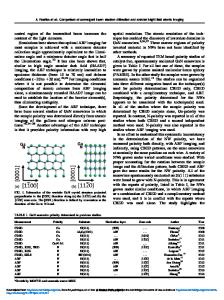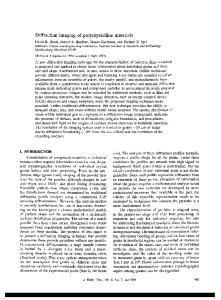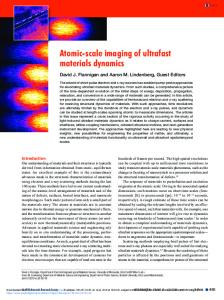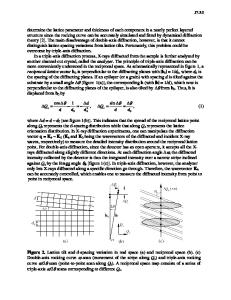Atomic Imaging of Metal-Semiconductor Surfaces Using UHV-Hrem and Diffraction
- PDF / 3,409,932 Bytes
- 10 Pages / 414.72 x 648 pts Page_size
- 24 Downloads / 275 Views
beams) is comparable to that obtained with current x-ray synchrotron sources, and the data set is far larger (100-500 independent beams) and only takes a few minutes to collect . Another is to use electron microscopy to image surfaces at very high resolution (atomic scale). In the plan view geometry this has not been too successful to date, although the related profile imaging is now very well established, but suffers from the problem that it is very difficult technique' to use on extended surfaces. The problem in plan view is that the signal levels from a surface in transmission are weak (typically 1%-2% of the incident beam7), much less than those normally used in high resolution electron microscopy (HREM) which are closer to 20%-40%. Furthermore, in the classic HREM approach of obtaining images along a zone axis this weak surface structure is buried among the much stronger bulk lattice fringe detail. In this note we will summarize some recent progress in obtaining atomic level information about surfaces using HREM and quantitative electron diffraction pattern analysis. The key components which have opened up the door to obtaining routine atomic-level surface images are quite old Wiener-filtering techniques8 , which can be directly coupled with equally old techniques for directly recovering the projected atomic potential9 .
181 Mat. Res. Soc. Symp. Proc. Vol. 355 01995 Materials Research Society
BACKGROUND TO IMAGING/DIFFRACTION THEORY FOR SURFACES Before proceeding any further, it is appropriate to give a little background to the imaging and diffraction theory appropriate for a surface in plan view. First, in order to obtain useful information about a surface one has to use conditions where the bulk scattering is reduced so that it does not completely conceal the surface information. As shown by a number of authors 2 '- , to achieve this one tilts off the zone axis to an orientation where the bulk spots are weak. Although this does lead to some loss in the intensity of the surface information 7 , the contrast level is increased by a factor of 5-20. One can write the diffraction from a surface (for convenience here the top surface only) in the form: 1P.
= jNTo(u")Tu",_u')Tb(u',u)du'du"
(1)
where Tju",,u') is the transmission function for the surface region, and Tb(_',U_) that for the bulk material, the vectors u are in reciprocal space and To u_)is the incident wave. When the crystal is tilted off the zone axis the bulk transmission term becomes small, and one can write: W(• = •fo(u")T(u",u_)du" + R,)
(2)
where R U) is a term included simply to take account of the errors associated with neglecting completely all the bulk scattering. Since the surface region is thin, one can use a simple phasegrating approximation and write: W(, = Wo(U)exp(-icrJV,()dz) + R'(.)
(3)
where V,(r) is the difference between a perfect bulk material (with a complete number of unit cells along the beam direction), and that with some sort of surface relaxations (e.g. reconstructions and sub-surface elastic strains). If the error i
Data Loading...









